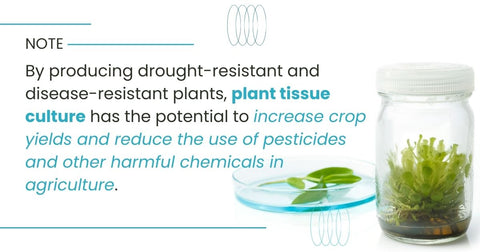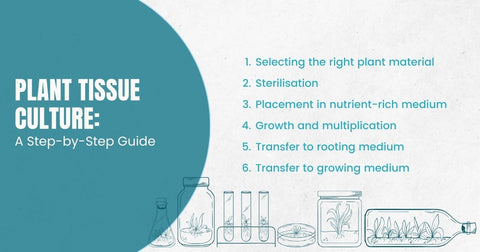If you're a plant enthusiast, you may have heard of plant tissue culture. This technique is used in propagation and cultivation, which involves growing plant cells in a laboratory setting. It has opened up new possibilities in the field of agriculture and floriculture across the globe. So, if you want to develop a green thumb with science, you're in the right place! In this beginner's guide, we'll explore the basics of plant tissue culture and how to use it in propagation and cultivation.
What is Plant Tissue Culture?
Plant tissue culture is a process that involves growing plant cells, tissues, and organs in a sterile environment outside of their natural habitat. For instance, florists or agriculturists take a small piece of plant tissue, such as a leaf or stem. Then, they place it in a nutrient-rich medium that provides the essential nutrients needed for growth.
To grow new plants from plant tissue, they place the tissue in a sterile container like a petri dish and put it in a controlled environment such as a growth chamber or incubator. The plant tissue will then grow and multiply, resulting in the production of new plants.
Advantages of Plant Tissue Culture
Plant tissue culture offers many benefits over traditional propagation methods. One of the most significant advantages is the ability to produce large numbers of plants within a short period. Moreover, this technique is useful for propagating rare and endangered plant species that may be difficult to grow in their natural habitat. Additionally, plant tissue culture enables the production of plants with specific traits, such as disease resistance and high yield.
What Does Culturing Plant Tissues Do For Us?
Plant tissue culture has many applications in the field of agriculture and floriculture. One of the most significant applications is the production of disease-free plants. This technique is an effective way to eliminate pathogens from plant material, resulting in the production of healthy plants.
Furthermore, plant tissue culture also has the potential to play a significant role in addressing food security issues and climate change. As the global population continues to grow, there is an increasing demand for food production. Using plant tissue culture techniques, it is possible to produce a large number of disease-free plants in a relatively short period. This could help meet the growing demand for food.
Moreover, by producing drought-resistant and disease-resistant plants, plant tissue culture has the potential to increase crop yields. It can also reduce the use of pesticides and other harmful chemicals in agriculture.

But that's not the end of it. Discovering better methods to cultivate plant tissues can help mitigate the impact of climate change. This can be possible by producing plants more resistant to extreme weather conditions, such as droughts and floods. Therefore, learning more about plant tissue culture can help with the sustainability of agriculture and reduce the risk of food shortages in regions affected by climate change.
To sum it up, the future of plant tissue culture is promising. It has the potential to revolutionise the way we produce food and protect the environment.
Essential Lab Items to Cultivate Plant Tissue
It's worth noting that culturing plant tissue is best done in a laboratory setting. That's because you can control the environment and ensure a sterile culture in a lab. Moreover, with the right materials and techniques, you can produce genetically identical plants for research or commercial applications. To start with plant tissue culture, you will need some essential items, including:
- Plant tissue culture media: This is a nutrient-rich solution that contains the necessary nutrients for plant growth.
- Sterilisation equipment: This includes items such as an autoclave, laminar flow hood, and sterilising solution to ensure that the culture is free from contamination.
- Plant growth regulators: These hormones are added to the culture media to promote plant growth and development.
- Instruments: You will need various instruments such as scalpels, tweezers, and forceps for tissue dissection and manipulation.
- Essential Containers: You will need sterile containers such as Petri dishes, flasks, and test tubes to hold the culture media and plant tissues.
- Lighting: Different plants have different lighting needs, and providing them with the right amount and type of light can make all the difference in their overall health.
Plant Tissue Culture: A Step-by-Step Guide
As we have mentioned before, one of the exciting features of culturing plant tissue is cultivating plant cells or tissues in a controlled environment. This process allowed for the production of genetically identical plants and more yield.
The plant tissue culture process involves the following steps:
- Selecting the right plant material: The first step is to select the plant material for use. This may include leaves, stems, or other plant parts.
- Sterilisation: Once the plant material is selected, it is sterilised to remove any microorganisms that may be present on the surface. This is to prevent contamination of the culture.
- Placement in nutrient-rich medium: Once sterilised, the plant material is placed in a nutrient-rich medium that provides the essential nutrients needed for growth. The medium may contain a combination of sugars, vitamins, minerals, and growth hormones.
- Growth and multiplication: The plant tissue is allowed to grow and multiply within the medium. This process can take several weeks or months, depending on the type of plant and the conditions provided.
- Transfer to rooting medium: After the plant tissue has grown, it is transferred to a rooting medium that encourages the development of roots. This is usually done by transferring the tissue to a medium containing a lower concentration of growth hormones.
- Transfer to growing medium: Once roots have developed, the plant tissue is transferred to a growing medium that provides the necessary nutrients for the plant's growth. This medium may be solid or liquid, depending on the needs of the plant.

Overall, plant tissue culture is a complex process that requires careful attention to detail. However, when done correctly, it can lead to the production of genetically identical plants that are useful in a variety of research and industrial applications.
Conclusion
Plant tissue culture is a fascinating world of propagation and cultivation. This technique has opened up new possibilities in the field of agriculture and floriculture. By using plant tissue culture, it's possible to produce large numbers of plants within a short period. It also eliminates pathogens from plant material, and produces plants with specific traits.
If you're interested in plant tissue culture, it's essential to maintain a sterile environment and use high-quality plant material. With patience and dedication, you can successfully grow plants using this technique.
FAQs and Recap:
What is the purpose of plant tissue culture?
Plant tissue culture propagates and cultivates plant cells, tissues, and organs in a controlled environment. It has various applications in agriculture and floriculture, including the production of disease-free plants, rare and endangered plant species, and plants with specific traits.
What are the advantages of plant tissue culture?
Plant tissue culture has several advantages, including the production of large numbers of plants within a short period, the propagation of rare and endangered plant species, and the production of plants with specific traits. It also allows for the production of disease-free plants and is particularly useful in the production of vegetables and fruits.
What equipment do you need for plant tissue culture?
You will need essentials such as plant tissue culture media, sterilisation equipment. Then you also need plant growth regulators, instruments, containers, and lighting to start with culturing plant tissues.
How long does the plant tissue culture process take?
Culturing plant tissue can take several weeks or months, depending on the type of plant and the conditions provided.
Can plant tissue culture be done at home?
Plant tissue culture requires a sterile environment and specialised equipment, making it difficult to do at home. It is usually done in research or commercial settings.
